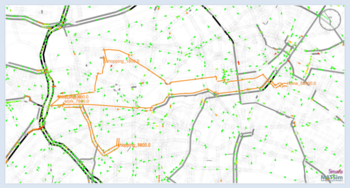Verkehrsverlauf in Berlin: Tagesplan einer synthetischen Person in orange, Positionen anderer Fahrzeuge in grün und rot, sowie die NOx-Belastungen (Stickoxide) auf den unterschiedlichen Kanten (in grau). © Kai Nagel / TU Berlin, VSP
What characteristics and interests do you give the synthetic humans in the simulation?
Wolf: Our agents want to maximize the benefits of their mobility choices, taking into account factors such as cost and convenience. They exchange information with other agents about the benefits of different modes of transport.
Nagel: At our company, every agent receives a daily schedule with goals they want to achieve. So they drive to work, go shopping, go to the gym in the evening, or meet up with friends—just like real people. These agents are then placed on virtual city maps and assigned work locations and so on. They choose their means of transportation based on criteria such as time and cost, and the means of transportation themselves also play an active role. For example, there may be traffic jams in the model if there are too many vehicles on a road.
Where does all the data on how people behave come from?
Nagel: In fact, traffic planning consists largely of empirical social research. Data has been collected for decades, including surveys of tens of thousands of people, traffic counts, population and company registers, and psychological studies. We can test our models by creating the conditions for well-researched effects in their synthetic world and seeing whether these effects are reproduced.
You are both members of the MATH+ Cluster of Excellence. Where do you encounter particularly tricky mathematical problems in your research?
Wolf: Simulating the behavior of millions of agents takes time, and we don't have that in a one-day workshop. To solve this problem, you can keep the number of options to choose from small and simply simulate all their combinations in advance. But if you really want to be live, you have to simplify the models. One way to do this is to use molecular dynamics methods and approximate the behavior of the agents using equations that can be calculated much faster. This also allows you to respond flexibly to complex compromise proposals from participants, such as when they suggest that the parking fee should not be tripled but only doubled, and in return the bus should only run every 15 minutes instead of every 10 minutes.
Nagel: The much-maligned compromise is, in fact, the norm when it comes to democratic decisions.
Wolf: Yes, ideally, our workshops are scientifically sound compromise machines!
Ms. Wolf, Mr. Nagel, thank you very much for talking to us!
Interview: Wolfgang Richter
What else can mathematics be used for? Here are some more examples →
Unusual science communication from MATH+: The comic “Ida and the Math Agent” →

